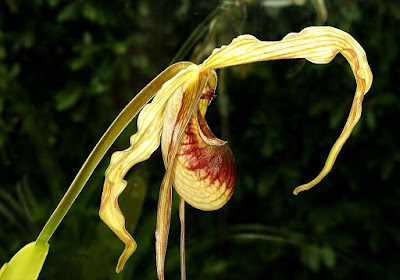Phragmipedium caudatum is native from southern Mexico to Peru. These plants usually grow at an altitude of 1500-2000 m, but they are even found at an altitude of 2590 m. They grow on forest trees, in shade in humus soil, or on cliffs facing north and west...
Phragmipedium caudatum also called as The Tailed Phragmipedium, the Mandarin Orchid, Cypripedium caudatum, Cypripedium elatum, Paphiopedilum caudatum, Phragmipedium humboldtii, Phragmopedilum caudatum, Phragmipedium caudatum f. albertianum, Selenipedium caudatum, Selenipedium caudatum var. albertianum, Uropedium lindenii, is a species of the genus Phragmipedium. This species was described by Robert Allen Rolfe in 1896.
IDENTIFY PHRAGMIPEDIUM CAUDATUM
Phragmipedium caudatum is native from southern Mexico to Peru. These plants usually grow at an altitude of 1500-2000 m, but they are even found at an altitude of 2590 m. They grow on forest trees, in shade in humus soil, or on cliffs facing north and west (in the southern hemisphere they have the highest insolation). These plants prefer the areas with leaking water.
It is a large sized, robust, caespitose, fan-shaped, cool to warm growing lithophyte, terrestrial or epiphyte, which reaching the size of 60-76 cm, with no pseudobulbs, with imbricate, conduplicate leaf-bearing sheaths carrying ligulate, leathery, distichous, 3 to 4 pairs, basally imbricating, glabrous, dark green conduplicate below into the base, 61-76 cm long leaves.
The Tailed Phragmipedium blooms from winter through summer with long lasting, simultaneously opening flowers on a sub-erect, terminal, to 60 cm long, 3 to 6 flowered, racemose inflorescences that is just longer than the leaves and has a large leafy basal bract and several prominent tubular bracts. The main part of the flower is 10-15 cm long, and the flowers are the largest in this genus. The yellow petals of the inner whorl hang down, they are twisted, similar to ribbons and have reddish veins. The side petals of the external whorl are narrow, twisted, yellow with green veins, while the dorsal petal is inclined over the lip. The white pocket is green at the base, purple-brown at the top and has pink dots.
PHRAGMIPEDIUM CAUDATUM CARE AND CULTURE
Cultural information should only be used as a guide, and should be to be adapted to suit you. Your physical location; where you grow your plants, how much time you have to devote to their care, and many other factors, will need to be taken into account. Only then can you decide on the cultural methods that best suit you and your plants.
Light:
Phragmipedium caudatum needs a light level of 24000-30000 lux and the plants should avoid the direct sun.
Temperature:
It is a plant with moderate thermal requirements. In summer the average day temperature is 28-31 ° C, night 14-15 ° C, which gives a daily difference of 13-17 ° C. For 3-4 months in winter, the average day temperature is 29-30 ° C, and the night is 7-12 ° C, which gives an exceptionally large daily amplitude of 19-22 ° C.
Humidity:
The Tailed Phragmipedium needs the humidity of 60-80% throughout the year.
Substrate, growing media and repotting:
A substrate that is fast drying but retain a part of moisture is necessary. You can use a mixture of chopped sphagnum moss and chopped tree fern fibers. Repotting is best carried out when new roots begin to grow.
Watering:
You need to ensure constant, even humidity of the substrate. Although the precipitation pattern is wet / dry, these plants often grow in areas with soaking water, indicating that moisture is available throughout the year.
Fertilizer:
During active growth, the plants should be fertilized every week or every two weeks with 1/4-1/2 of the recommended dose of fertilizer for orchids. Given that these plants often grow in areas rich in organic components, it is recommended to use organic fertilizer.
Rest period:
In winter, watering, humidity and fertilization should be limited, while the amount of light can be slightly increased to simulate an increase in the number of cloudless days.















COMMENTS